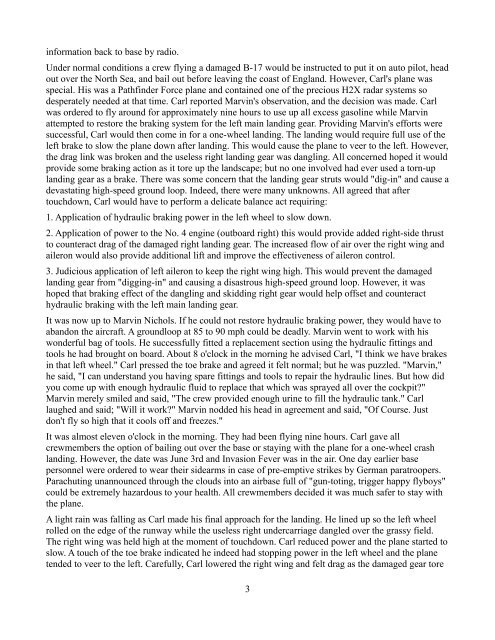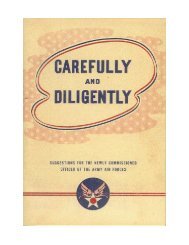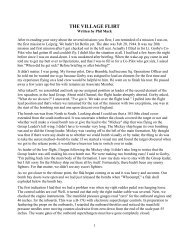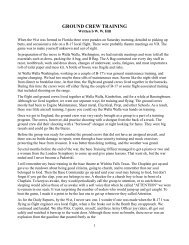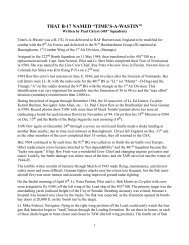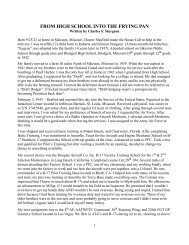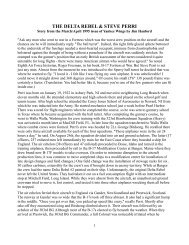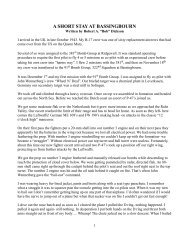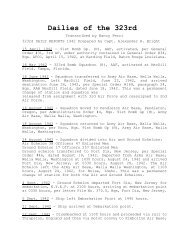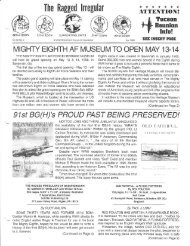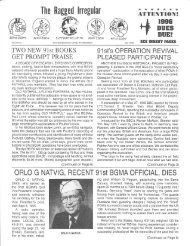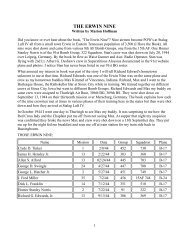CARL CLARK AND THE UNFORGETTABLE ... - the 91st Bomb Group!
CARL CLARK AND THE UNFORGETTABLE ... - the 91st Bomb Group!
CARL CLARK AND THE UNFORGETTABLE ... - the 91st Bomb Group!
Create successful ePaper yourself
Turn your PDF publications into a flip-book with our unique Google optimized e-Paper software.
information back to base by radio.<br />
Under normal conditions a crew flying a damaged B-17 would be instructed to put it on auto pilot, head<br />
out over <strong>the</strong> North Sea, and bail out before leaving <strong>the</strong> coast of England. However, Carl's plane was<br />
special. His was a Pathfinder Force plane and contained one of <strong>the</strong> precious H2X radar systems so<br />
desperately needed at that time. Carl reported Marvin's observation, and <strong>the</strong> decision was made. Carl<br />
was ordered to fly around for approximately nine hours to use up all excess gasoline while Marvin<br />
attempted to restore <strong>the</strong> braking system for <strong>the</strong> left main landing gear. Providing Marvin's efforts were<br />
successful, Carl would <strong>the</strong>n come in for a one-wheel landing. The landing would require full use of <strong>the</strong><br />
left brake to slow <strong>the</strong> plane down after landing. This would cause <strong>the</strong> plane to veer to <strong>the</strong> left. However,<br />
<strong>the</strong> drag link was broken and <strong>the</strong> useless right landing gear was dangling. All concerned hoped it would<br />
provide some braking action as it tore up <strong>the</strong> landscape; but no one involved had ever used a torn-up<br />
landing gear as a brake. There was some concern that <strong>the</strong> landing gear struts would "dig-in" and cause a<br />
devastating high-speed ground loop. Indeed, <strong>the</strong>re were many unknowns. All agreed that after<br />
touchdown, Carl would have to perform a delicate balance act requiring:<br />
1. Application of hydraulic braking power in <strong>the</strong> left wheel to slow down.<br />
2. Application of power to <strong>the</strong> No. 4 engine (outboard right) this would provide added right-side thrust<br />
to counteract drag of <strong>the</strong> damaged right landing gear. The increased flow of air over <strong>the</strong> right wing and<br />
aileron would also provide additional lift and improve <strong>the</strong> effectiveness of aileron control.<br />
3. Judicious application of left aileron to keep <strong>the</strong> right wing high. This would prevent <strong>the</strong> damaged<br />
landing gear from "digging-in" and causing a disastrous high-speed ground loop. However, it was<br />
hoped that braking effect of <strong>the</strong> dangling and skidding right gear would help offset and counteract<br />
hydraulic braking with <strong>the</strong> left main landing gear.<br />
It was now up to Marvin Nichols. If he could not restore hydraulic braking power, <strong>the</strong>y would have to<br />
abandon <strong>the</strong> aircraft. A groundloop at 85 to 90 mph could be deadly. Marvin went to work with his<br />
wonderful bag of tools. He successfully fitted a replacement section using <strong>the</strong> hydraulic fittings and<br />
tools he had brought on board. About 8 o'clock in <strong>the</strong> morning he advised Carl, "I think we have brakes<br />
in that left wheel." Carl pressed <strong>the</strong> toe brake and agreed it felt normal; but he was puzzled. "Marvin,"<br />
he said, "I can understand you having spare fittings and tools to repair <strong>the</strong> hydraulic lines. But how did<br />
you come up with enough hydraulic fluid to replace that which was sprayed all over <strong>the</strong> cockpit?"<br />
Marvin merely smiled and said, "The crew provided enough urine to fill <strong>the</strong> hydraulic tank." Carl<br />
laughed and said; "Will it work?" Marvin nodded his head in agreement and said, "Of Course. Just<br />
don't fly so high that it cools off and freezes."<br />
It was almost eleven o'clock in <strong>the</strong> morning. They had been flying nine hours. Carl gave all<br />
crewmembers <strong>the</strong> option of bailing out over <strong>the</strong> base or staying with <strong>the</strong> plane for a one-wheel crash<br />
landing. However, <strong>the</strong> date was June 3rd and Invasion Fever was in <strong>the</strong> air. One day earlier base<br />
personnel were ordered to wear <strong>the</strong>ir sidearms in case of pre-emptive strikes by German paratroopers.<br />
Parachuting unannounced through <strong>the</strong> clouds into an airbase full of "gun-toting, trigger happy flyboys"<br />
could be extremely hazardous to your health. All crewmembers decided it was much safer to stay with<br />
<strong>the</strong> plane.<br />
A light rain was falling as Carl made his final approach for <strong>the</strong> landing. He lined up so <strong>the</strong> left wheel<br />
rolled on <strong>the</strong> edge of <strong>the</strong> runway while <strong>the</strong> useless right undercarriage dangled over <strong>the</strong> grassy field.<br />
The right wing was held high at <strong>the</strong> moment of touchdown. Carl reduced power and <strong>the</strong> plane started to<br />
slow. A touch of <strong>the</strong> toe brake indicated he indeed had stopping power in <strong>the</strong> left wheel and <strong>the</strong> plane<br />
tended to veer to <strong>the</strong> left. Carefully, Carl lowered <strong>the</strong> right wing and felt drag as <strong>the</strong> damaged gear tore<br />
3


